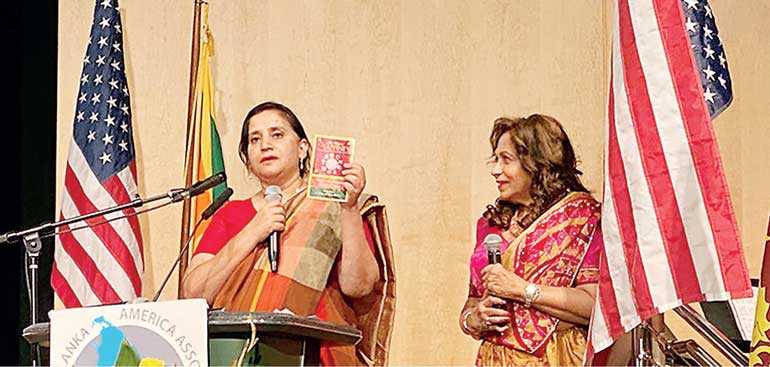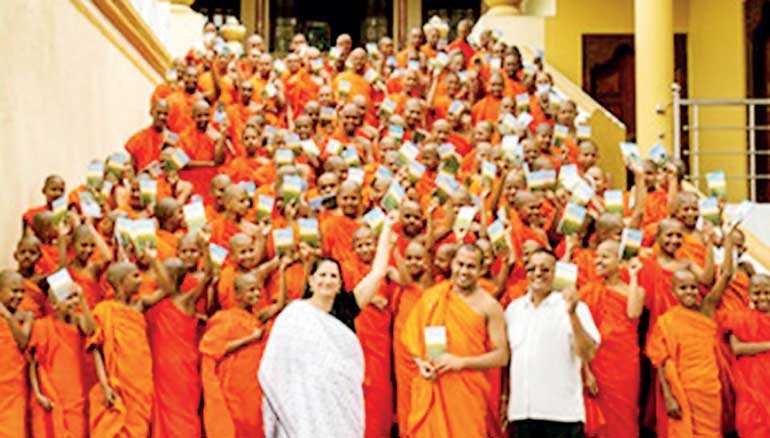Friday Dec 26, 2025
Friday Dec 26, 2025
Monday, 2 March 2020 02:39 - - {{hitsCtrl.values.hits}}

Aeshea Jayasinghe (right) and Naseema Qureshi at the Sri Lanka Independence Day celebration in Los Angeles: Church of Scientology International
By Hassina Leelarathna
In a message published in the Sri Lanka America Association of Southern California’s (SLAASC) souvenir to mark its Independence Day 2020 celebration, the association’s President claimed his group was “back in the saddle, in organising the signature event”.
Well, not quite, as evidenced by a press release issued 19 February by the Church of Scientology.
In fact, all signs are that SLAASC, among the oldest Sri Lankan expat community groups in the US, is the latest outpost to capitulate to the mighty Church of Scientology.
In good ole cowboy style, SLAASC bartered bragging rights to the church in exchange for free use of one of its facilities and to Scientology’s leading advocates Dr. Walter Jayasinghe and wife Aesha for a cash donation of $ 7,000.
In the press release dated 19 February, the Church of Scientology International makes no mention of SLAASC, headlining the event as one where ‘The Southern California Sri Lankan community gathered at the Church of Scientology of the Valley to celebrate their freedom from English rule’.
In addition, and most importantly, the Church, represented by Way to Happiness Ambassador to South Asia Naseema Qureshi, and the Jayasinghes, got a captive audience at Sri Lanka Independence Day where it ran a 30-minute long video highlighting its work in Sri Lanka.
While the showing of the video to the largely Sinhala Buddhist audience, including monks from the local temples, was indicative of Scientology’s influence in the expatriate community, its contents provide troubling details on the wide swath it has cut into the highest echelons of Sri Lankan Government including the President’s Office (under President Sirisena). The Church boasts it has made inroads into various branches of Government in Sri Lanka and the Buddhist communities.
“Today, The Way to Happiness is widely used in schools and Government institutions across all of Sri Lanka,” says Qureshi.
The Scientology video flashes photos of the infamous LTTE/Channel 4 propaganda picture of a blindfolded man allegedly being executed by the SL military during the 30-year civil war and ‘insurgency’. It goes on to declare that there’s rampant “religious tension” in the country with 56% of districts in Sri Lanka reporting “religious discrimination”.
Qureshi then teams up with an “advisor” from former President Sirisena’s Office, Dr. Samantha Kumara, and presents several Way to Happiness seminars for hundreds of Sri Lankan Police, Air Force, Army, and Navy personnel with the stated aim of providing them with a “workable solution” to deal with conflicts.
“For the first time, people were reaching out to the Police to teach and educate them on looking after themselves and their families,” Qureshi asserts showing pictures of uniformed Police and Army personnel on the streets and getting on and off buses distributing Scientology’s Way to Happiness. Thanks to the Scientology hand-outs, the Sri Lankan people were suddenly realising that fighting was not a solution, according to Qureshi.
Beaming school children, smiling three-wheel drivers, and young Buddhist monks, are all featured waving L. Ron Hubbard’s Way to Happiness.
How much has the church and/or Dr. Jayasinghe poured into the pockets of powerful Sri Lankan politicians to get the country’s security agencies working as foot soldiers spreading L. Ron Hubbard propaganda?
In the press release dated 19 February, the Church of Scientology International makes no mention of SLAASC, headlining the event as one where ‘The Southern California Sri Lankan community gathered at the Church of Scientology of the Valley to celebrate their freedom from English rule’
Dollar figures are being floated in the community, upwards of $ 100,000 by some accounts.
And the numbers are believable given the size of the Jayasinghe fortunes. Publicly available documents show the Jayasinhala Foundation, a private non-profit launched in 2014, having $ 1.8 million in revenue and $ 49 million in assets.
In addition to the Jayasinhala Foundation, Dr. Jayasinghe controls the Sri Lanka Foundation, Sri Lanka Buddha Dhamma Society and the Los Angeles Medical Center Foundation which in 2015, received $ 400,000 from the Jayasinhala Foundation for the stated purpose of ‘Religious work/planetary dissemination’. “The [Jayasinhala] Foundation lacks transparency and does not maintain a website, which makes it difficult to locate further information on its priority areas,” writes Stacey Suver, a senior editor at Inside Philanthropy. Suver notes that in a recent fiscal year, the foundation gave away around $ 2.3 million. Grantees include Sri Lanka Medical Association, Church of Scientology, and Bridge Publications which publishes L. Ron Hubbard’s books in 50 languages.
Publicly available information also suggests that virtually all the Sri Lankan Buddhist temples in the Los Angeles have received funding from one or another of the maze of non-profits under Dr. Jayasinghe’s control. Amounts have varied from the low thousands to over half-a-million dollars as a gift to one temple.
A notable exception is the Dharma Vijaya Buddhist Vihara in Los Angeles, whose founder Ven. Walpola Piyananda Nayake Thera politely declined to accept Dr. Jayasinghe’s gift of $ 75,000 offered for his 75th birthday.

How important is Sri Lanka to the Church of Scientology?
It boils down to a case of survival. If it is to endure and thrive, the Church needs new frontiers. In the US, its numbers are said to be declining.
Author of Battlefield Scientology: Exposing L. Ron Hubbard's dangerous ‘religion’ Tony Ortega believes Scientology numbers peaked in 1990s with roughly 100,000 members worldwide but that membership has declined to around 20,000. The Church vigorously contests such stats, claiming that it has “millions of parishioners in 167 nations, a third of whom are in the US”.
Prof. Stephen A. Kent of the University of Alberta in Edmonton, considered a leading expert on Scientology who has been tracking its activities for several decades, shares the view that plagued in recent years by numerous scandals and public relations crises the church is in decline. “Historically, most new religions die, and it's fairly clear now that Scientology is on a downward path,” said Kent.
Evidence abounds of Scientology actively looking for and investing in new frontiers overseas. In January 2019, it opened an elaborate new African headquarters in a sprawling castle outside of Johannesburg, South Africa. In Latin America, pop singers and television personalities are making the rounds promoting the Church.
In Ireland, where its numbers are said to be just 87, Scientology remains undeterred and has made a multimillion-euro investment in three new facilities in Dublin.
The Church is known to show up after natural disasters such as the Indonesia earthquake, the Ugandan mudslide and the mosque shooting in Christchurch, New Zealand where Scientology volunteers pass out Hubbard’s The Way to Happiness. Journalist and long-time Scientology critic Mark Ebner sees these efforts as “recruiting expeditions on the most vulnerable”.
Scientology debuted in Sri Lanka in 2005 when its members were seen distributing church leaflets after the devastating tsunami. It has been registered since August 2006 as a limited company under the name of ‘Scientology Applied Religious Foundation of Sri Lanka’. Its Dianetics Centre in Nugegoda offers the church’s signature ‘Dianetics Auditing’ – a controversial system used in place of psychiatry or psychological counselling for mental problems.
At the crux of Scientology is the belief that through the utilisation of Dianetics individuals can cleanse their minds and attain ‘new state of spiritual awareness called Clear’ which is a form of enlightenment derived, in part, from the Buddhist concept of Bodhi. Scientology founder L. Ron Hubbard claimed he was Maitreya Buddha in his 1955 book Hymn of Asia An Eastern Poem.
While the number of Scientology adherents in Sri Lanka is not known, it might well be on the cusp of a major take-off, especially with the backing it is receiving from very powerful politicians. That Police and other government officials have been deployed to spread Scientology speaks for itself.
In Los Angeles, Dr. Jayasinghe’s generosity via his numerous non-profit foundations assures the Church of a front pew at Sri Lankan events. A musical show or other community event that doesn’t receive Jayasinhala dollars and/or staged at a venue other than at a Church of Scientology venue has become a rarity.
Noteworthy is that while a church facility may be obtained free-of-charge, there’s still a price to pay: it requires the audience to watch a Scientology video at the start of the event. In addition, books containing the Church’s teachings are distributed at the venue.
“It’s no secret that the Church of Scientology is actively trying to convert Buddhists in Los Angeles,” said Dr. Sunil Jayasinghe, author of several books on Buddhism, notably The Last Meal of the Buddha when asked to comment on these trends. “I know because I myself have been approached.”
The Church also gets a stall to distribute its literature at ‘Sri Lanka Day’ – the flagship event of the Sri Lanka Foundation usually held in mid-August to coincide with Dr. Jayasinghe’s birthday. The daylong street fair provides local artists a stage to perform while, for a sizeable fee, Sri Lankan eateries can sell their food. The event culminates in a perahera where the Jayasinghe family and the local city mayor ride in an open car waving to the crowd of Sri Lankan expats lining the street.
While Scientology’s inroads into the community have gone unchallenged, the Church’s predominance at this year’s Independence Day event is being noticed with unease. According to Sunil Jayasinghe, there’s concern among long-time residents but they’re reluctant to talk about it. “I think it’s time for open discussions on this issue, especially, as it will have a huge impact on our future generations,” he said.
(The writer can be contacted via email on [email protected])